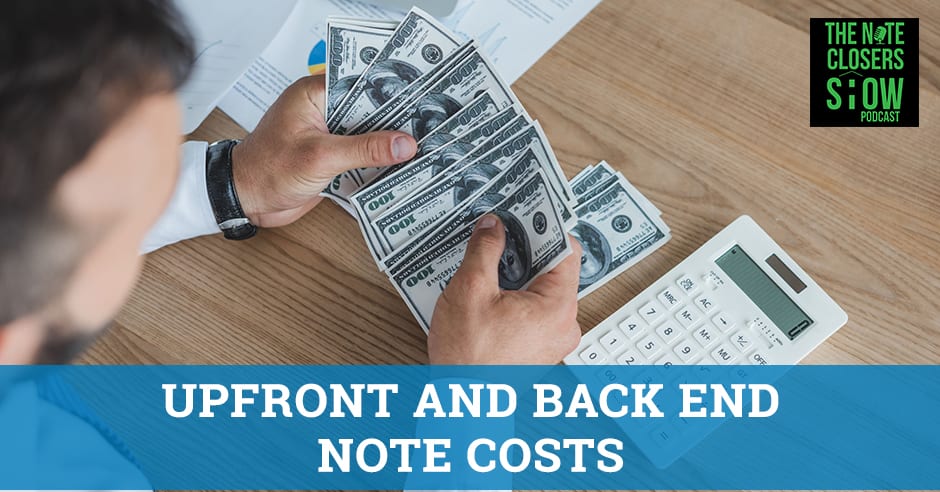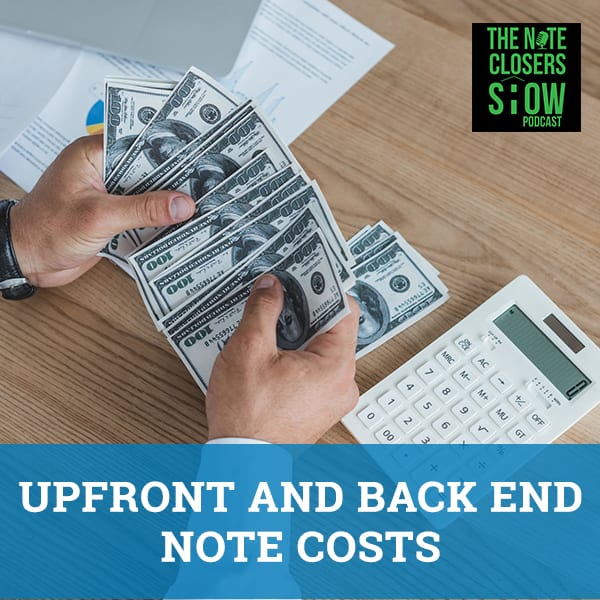
—
Listen to the podcast here
Upfront And Back End Note Costs
One of the things that I thought I’d talk about is the note costs. The things that you have to pay for before and after you buy a note. A lot of people forget to put this into their calculations. They forget to consider this. It’s not a simple, “Buy it and then I’m going to sell it.” You’ve got costs along the way. I’ve had conversations with people that are doing this incorrectly. They’re not adding these costs into their ROI calculator. Figure in their backend cost or their frontend cost of purchasing the note and they’re wondering why their numbers are off. It’s simply because they’re not putting the right things in. What I thought I’d first do is start with talking what you need to focus on beforehand and run through some of the costs, some of the items you want to consider definitely on the frontend before you end up purchasing the note. When you’re buying a note, you’re going to take a look at a couple of things. First of all, you have got due diligence costs.
What You Need To Think Beforehand
Let’s talk about some of those due diligence costs that are important. There are marketing costs on the frontend. Pulling numbers, paying for a BPO or a realtor drive by, those are costs. O&E, ownership and encumbrance reports from ProTitleUSA, those are costs. It’s not a full-title report but it’s still $85, $90 depending on where it’s located. A BPO could cost you $125, $150. A realtor drive-by could be $50 to take some photos for you. Other marketing costs like links, if you’re going to use Canva for marketing images. That’s $1 a photo. Or using a software, your website, cell phone bills making phone calls, email, and CRM tools. Those are all little things that add up throughout the month. You want to keep that in mind as well. The bankruptcy note, you’ve got to go to Pacer and pay for Pacer. That’s a few bucks. If you’re going to have the collateral reviewed by somebody, which could be relatively cheap, if you’re going for Richmond Monroe or something like that, it’s tiny. It’s $100, $250 an hour if you’re having attorneys look at it. Those are upfront costs initially that may not be covered. You’ve got to keep that in mind when you’re looking at the ultimate funding amount.

Note Costs: Make the repairing costs worth your time that what you are putting makes more than enough.
If you’re going to be funding this stuff yourself, keep that in mind. Maybe you have some relationships that don’t cost you anything to do. Maybe you know a realtor, maybe you know somebody in the WCN Crew that can drive by for you. Those are different things to look at, but your costs like your BPOs are going to be costs. Your O&Es are going to cost. Your doc review is going to be cost for sure, and then the Pacer and paperwork aspect of this will give you a little cost as well. Those are frontend costs. Time is another thing that we’re not putting in here as a cost. Your time to do due diligence, your time for marketing out. Those all add a cost to the overhead of your business. If you’d rather be out at the movies, that’s great. There’s nothing wrong with that. You’re just not going to find any assets. You got to keep that in mind with your marketing. My email system that we use, Infusionsoft, runs me about $500 a month because we have a big database, we run a lot of things through it. For those who have less than a 25,000-person database, MailChimp may be the best thing for you and that’s still going to cost you $35, $50, $150 a month depending on how many more contacts you have as well. That’s something that’s an overhead cost that’s running the business. If you have an office, you’ve got to throw in there your cell phone bill, $100 a month or whatever. You got to keep that in mind as well.
What To Do Once You Bought A Note
Let’s talk about once you fund. Once you’ve bought a note, what do you do with it now? First and foremost are your taxes. If there are taxes owed, you’ve got to pay before it goes to tax foreclosure, that’s an important number. One of the most important amounts that you need to know is right off the bat, what’s the situation with taxes? Are they paid? Have they not been paid? You want to protect your asset with insurance, so you’ve got to get a quote. Do you know how much you are insuring it for? Is it for what you paid for the note? Is it insuring for the full UPB? Is it replacement cost? Is it the market value? Is it a percentage of that? You’ve got to know that based on what you end up funding and going from there. Servicing costs, you have boarding fees. You’ve got monthly servicing fees. Is it a nonperforming note? Are you doing workouts? Are you having Madison handle the workout for you at $90 a month? If it’s a performing note, drop it down to save you $20 a month. Are you going to have a special servicing company like Polaris or the Singer Law Group handling the file as well? That’s going to cost you à la carte fees. Are going to add that into your cost of doing business?
Utilities, if you take the property back. You’re going to have to pay to get the lawn mowed, get the utilities, the water and power. Those are costs along the way as well for you. Foreclosure costs, if it’s in a judicial state, that’s going to cost you more than a non-judicial state. If it’s in Florida, it’s probably going to cost you $5,000 to foreclose, others may be $3,500. If it’s a non-judicial state, maybe less than $1,000 like it’s here in Texas. Filing fees, you’re going to file documents. You’ve got to get stuff recorded for accounting. Those are costs associated with that stuff as well. Marketing costs on the backend too. Paying to get photos taken, paying to post it in other places. Maybe you’re paying to do a video on the property. Those are services that you’ve got to help move it, they’re overhead costs. Let’s not forget title cost to close.
If selling the asset off, you’ve had to foreclose and take the property back. You got some fees per title cost, closing things, realtor commissions. Those will come out of closing on that number, but you want to keep that in mind. If you’re buying a note at $25,000 and it values $50,000, you’re not going to sell it at $50,000. You’re probably going to sell it at $45,000 and then you got to remove your commissions off of that, especially in the last two with closing costs and realtor commissions. If I expect to sell an asset at $0.90 on the dollar to get a fast sales price, I have to take another 10% off of that for commissions. I’m going to figure roughly my net as long as there are not a lot of taxes. It’s probably about 80%, 81% of what my value is. I listed it at 90%, coming at 90% of that, that’s 81%. 90% times 90% is 81%. I got to figure out the costs along the way. Are there legal costs? That cost me $5,000. It cost me another $1,000 to get these utilities on and those paid up-to-date.
What To Consider Upfront
One thing you’ve got to keep in mind too that’s not even listed in here is the repair costs. If you have to put any repairs into the property, what’s that going to cost? My buddy Wayne Snell liked to talk about you’re probably going to have to replace at least one major thing, electrical or air conditioning, plumbing, maybe the roof too. Are you going to make more than enough to replace that, make it worth your time? If we go back and remodel the house, you got to make sure that if you’re going to go from selling it from $100,000, it’s going to worth $150,000 at least. That you’re not putting more than $25,000 into it. This is why I don’t like heavy repairs. It’s also why we like occupied assets. Occupied assets have less chance to make major repairs because they haven’t gone vacant. Somebody’s there to watch the air conditioner every night. Somebody’s there to make sure the copper goblins don’t show up. Somebody’s there to make sure that the pipes don’t burst in the middle of the winter and you have an interior ice skating rink or a winter water feature. Those are important things to consider and some of these things you can figure on the frontend. One of the things you got to keep in mind on the frontend is that make sure that you’re buying right.
Recap
This is the thing that drives me a little bonkers a little bit. I see people complain about pricing. It’s overpriced because they’re buying one or two assets. If you’re cherry-picking the best assets out of the tape or a tape, you have to expect to have extreme pricing because you’re going to leave the seller with a bunch of trash. Keep in mind that if you’re buying something at pristine price, you got to make sure it’s clean. Make sure that if you add in these costs, it’s still going to be profitable for you. If you’re going to pay over $0.70 on the dollar, you might as well wait and not buy any notes anymore. You might as well buy REO and figure that aspect out, going to the full fix and flip market. Not every deal’s going to have these all added in because if you start adding all these costs in on the frontend or the backend a lot of times, it’s going to kill your ROI calculator.
It’s important to have an ROI calculator. I know that doesn’t make sense sometimes like, “Every day I run by these numbers.” First and foremost, the thing to keep in mind as well as if it’s an occupied asset, you have an opportunity to get reinstated or modify it. If that happens, you’re going to not have as much in legal fees. You’re not going to have as much in repair costs. Hopefully, the borrower is paying their taxes and insurance so you may not have that. Scale a little bit. It’s extreme this way, but as you start doing it and start doing some scheming, take away some of these features. Are there assets that we’ve bought that were occupied that we thought we’d get reinstated and modified that turned to a foreclosure? Of course, I totally agree to that. Are there assets that we thought would foreclose that turned into modifications and reinstatements? I totally agree with that. This is why it’s important in your marketing, in your due diligence of the asset to take a look at things. If you can get the servicing comments from the servicer or from the seller, that will help you to tell you if the borrower would like to stay. If the borrower told the servicer to go pound sand, you’re probably not going to get her reinstated, but they’ve sent in hardship letters.
They’ve sent in loan modification packages or short sell packages. That tells you that the borrower is probably ready to roll. If you look online and see that the property was listed for sale in a short sale within the last several months, the borrower’s probably ready to move on. That could be deed in lieu. You’re going to avoid a lot of legal costs. What I would do with a deed in lieu or cash for keys is make sure that the borrower’s leave it in pretty good shape. It doesn’t have to be eating off the floors clean, but there can’t be trash everywhere. This is why you’re going to want to always pad what you buy. If you’re buying an asset at $20,000, you do not necessarily want to go have $20,000 funded. You want to make sure and add some money to that to have covered your backend costs, to help you recuperate some of the costs. I know people that add-on management fees to their funding amount so that they cover some of their costs along the way.
You can put those into your funding agreements or your JV agreements. That we’re going to have an extra $5,000 per asset funded. Some people are like, “That’s extreme.” It is so I don’t have to come back to the well. I don’t have to come back and ask you for more funds for legal. It’s there. Some of the funding groups we have to fund extra because of this $20,000 going to the note. We’re going to have you fund $2,500 towards legal costs. There’s a $1,000 in servicing cost we’re going to put in there and then another $1,500 in miscellaneous fees like utilities, marketing, and title. Those are all completely legitimate expenses and you want to add that in. If you don’t have to pull title because they reperformed or you don’t have to pay $150 or $250 for a BPO because you’ve got a great realtor to drive by, that’s great but still have that stuff funded to pad to your numbers. At some point, you’re going to need those funds. If you get $5,000 funded per asset, you probably maybe only use $5,000 every other asset. The other stuff will come in handy and it’s there to help you when you have the unexpected expense, like having to replace an air conditioner twice because the first one gets stolen. It’s not a fun time at all.
On the before side, the due diligence side, you always got to check taxes. You may hire a company to do that for you. You’re going to have to pay for BPOs, pull values, O&Es, Pacer, document review, and then any other marketing costs. Those are the six upfront costs we’re going to look at. Before you fund, you should know some of your backend cost. If you’re going to have to pay taxes, you’re going to let the taxes ride. Sometimes we’ll pay the taxes, other times we won’t pay the taxes because we’re going to have to foreclosure. Insurance is the second thing. Servicing costs, servicers should be able to provide that. Legal foreclosure costs. If you’re going to have a special servicer like Singer Law Group or Polaris come in, that’s another thing. Filing fees, you got to file with the city. You got to file with the county. You get your documents filed to transfer ownership. Marketing costs to market asset after you’ve done the workout. Another thing I didn’t throw it in here, which I consider legal, is your cash for keys.
I always figured that if I go in legal and I offer cash for keys. I’ll offer $2,000 right off the bat a lot of times to the borrower because that’ll end up saving me $5,000 in the long run. That’s where I get the cash for keys number from. Any repair costs along the way. You’re always going to have to probably clean out a property and have a make ready team go through if you take the property back or before you sell it off and closing costs and realtor commissions on the backend. You have more costs in the backend than in the frontend, but that’s okay because you’re hopefully buying and making your spread in the backend. That’s the beautiful thing about buying on the frontend is if you’re buying at $0.50 on the dollar or less, you hopefully have enough as long as you’re buying assets in the $50,000. This is why it’s important that the lower valued assets below $50,000 you’re buying, you’ve got to be very careful of what condition they’re in. That’s why I would not buy any vacant assets at all below $50,000. Try to keep the occupied aspect of that because you don’t have to do as many repairs if you get them modified or reinstated.
You can’t add all these upfront costs to your due diligence, but you have some info. You need to know the numbers. If it does go this, this is what’s going to happen. If it does go this, here’s how we’re prepared. This is why the speed of liquidity is important because while sometimes if you close an asset out and then sell it, it may not be a huge payday, but the ROI looks good. That’s just as important sometimes to your funding partners and investors as well. Money costs are important too. If you’re doing a split, you got to keep that in mind versus a flat return on investment. You want to figure in your money costs on the backend too. If you’ve got a flat ROI, 6%, 8%, 10%, 12% whatever, you invest your money costs in the backend to see if you walk away with any money.

Note Costs: Having a good-looking ROI is just as important to your funding partners and investors as well as money.
Foreclosure Cost
One of the things I would highly recommend if you’re buying in non-judicial states, your foreclosure costs will be a lot cheaper. Judicial states will be a lot longer. New York and New Jersey is going to cost you the most there. Chicago and Illinois could probably be the next Florida. Florida’s gotten a lot faster over the years but it can still drag on, especially when you have things going on or if you’re in a hurricane area, you want to double check your insurance costs because your insurance costs often go up. Another thing that’s not figured into here on the backend side is HOA fees if you’ve got a homeowner’s association fees that have to be paid up because you’re foreclosing. If you’re in Colorado, Florida, you got Safe Harbor Laws that can help limit the amount of HOA fees you’re paying. It’s good to know that when you’re looking at that cost because that’s going to be paid at closing to the HOA as well. Those are some of the things to keep in mind that you may want to make a running list of that. Not every one of those costs is going to be paid, but it’s good to know about them so you can check them off your list. How much do we have to worry about? The more you do, the more that you’re able to realize, “We can figure out stuff there as well.”
One of the things that I see people screw up with a lot is they started getting a rehab and they don’t have a clue of what it’s going to cost them. Before you look at rehabbing, you figure out costs and stuff like that. Reach out to local hard money lenders, talk to the local rehabbers like, “What’s it cost to put a kitchen in these days? What’s it cost to put paint and carpet?” You’re in three different levels. You’re going to have the low level, the base level, cheapest, middle, and high end. If you get into rehabbing a property, one of the best things that I like to do is to get the exterior looking nice so that you get foot traffic. You definitely want to highlight the kitchens and the bathrooms. Don’t worry so much about bedrooms unless it’s the master suite. The other bedrooms, you can knock out the last minute because nobody cares about the other bedrooms. It’s those big things, kitchens, bedrooms, and curb appeal. If you have something unique in the living room, whether it’s a fireplace or something like that, that’ll help with people imagine themselves living there. A lot of times I try to sell the asset before we ever finish up so people can pick out their own appliances.
We have a question, “Does an O&E catch city, utility or mechanics liens?” They catch it as long as it’s filed. Ownership and encumbrance reports are like they say. It’s an ownership that should check whose ownership and encumbrance. Any encumbrance is entitled as long as they are filed. This has happened to me a couple times before. We were trying to sell the property in 90 days. In some areas of the country, you’ll occasionally find some unscrupulous people that’ll go around and slap liens on properties hoping that you’ll pay them versus suing them. It costs more to hire an attorney to get it done versus just paying off. We’ve run into that in a couple of places over the years. It’s not as widespread as it used to be, but you’ll run into that occasionally.
Mechanics liens, you got to be careful. This is why it’s important for you to keep in mind if you’re rehabbing a property when you take the REO back, when you take the property back as an REO. If you don’t sell to the foreclosure auction, put a lien on the property to over-encumber what the property’s going to be worth. So that way before you start bringing on a rehab crew that maybe does a crappy job, they can’t go and slap a mechanics lien on it that ties up that equity. You want an encumbrance of the house that’s worth $130,000 when it’s going to be said and done. Put a lien on it for $150,000. If the unscrupulous contractor comes on and slaps a lien for $10,000, it’s in a junior lien position that has no equity that you can wipe that out via foreclosure. That’s doing a friendly foreclosure. That’s an advanced asset protection strategy. Go make something happen and we look forward to seeing you on the top.

